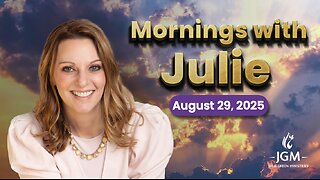Premium Only Content

Are Key Market Indicators Signaling Something Big? - Andy Tanner
Host Andy Tanner is joined by financial experts Noah Davidson and Corey Halliday to break down recent market movements and discuss key strategies for navigating the constantly shifting financial landscape. Whether you’re a seasoned investor or just starting out, this episode offers valuable insights into risk management, market indicators, and the importance of preparedness in investing.
Recent Market Movements: A Blip or a Sign?
The episode kicks off with a discussion about the recent market dive, which sparked concerns among investors. While some feared a significant downturn, the consensus among the experts was that this was not a systemic issue but rather a temporary blip caused by a significant institutional squeeze leading to heavy liquidations. Corey Halliday noted that despite the spike in the VIX (Volatility Index), which measures market volatility, the situation was more of an anomaly than a reflection of a looming crisis.
Understanding the VIX and Market Sentiment
The VIX, often referred to as the "fear gauge," is crucial for investors to understand. It measures the market's expectation of volatility and spikes when there’s high demand for options to hedge against risk. While the recent VIX spike suggested fear levels comparable to past financial crises, Corey explained that this was more of a bad tick than an accurate reflection of market conditions.
Advanced Risk Management: The ARMOR Strategy
In response to market volatility, having a solid risk management strategy is essential. The ARMOR strategy—Advanced Risk Management and Opportunity Readiness—was introduced as a way to help investors prepare for downturns and capitalize on market pullbacks. Corey shared an example of how buying VIX options when the index was low turned out to be highly profitable during the recent volatility spike, illustrating the importance of being prepared.
Key Market Indicators: Consumer Discretionary Spending and Sector Rotation
Noah Davidson highlighted the significance of monitoring consumer discretionary spending as an indicator of economic health. A shift from discretionary stocks to staples and defensive sectors often signals that institutions are playing defensively, anticipating potential economic downturns. This sector rotation is a proactive strategy used by institutions to brace for market shifts.
Preparing for Bigger Economic Moves
While the market remains stable for now, Corey suggested that we might not be far from an economic situation that could see larger dominoes falling. Potential rises in unemployment and other economic stressors could create a more challenging environment in the near future.
Housing Starts and Their Economic Impact
Andy Tanner pointed out the importance of housing starts as a key economic indicator. With high-interest rates cooling the housing market, fewer people are selling their homes to buy new ones, which could signal broader economic challenges.
Education and Readiness: Key to Successful Investing
The episode concludes with a strong emphasis on the importance of education and readiness in investing. Andy stressed that being mentally and tactically prepared is just as crucial as having the financial means. Advanced strategies like Delta hedging or using futures to manage risk can make a significant difference in navigating market complexities.
FREE Training with Andy Tanner: https://bit.ly/3U3HAPY
00:00 Introduction and Market Overview
04:26 Market Volatility and the VIX
06:31 Insurance and Risk Management Strategies
09:38 Special Class: ARMOR
13:22 Trading Strategies and Historical Context
24:31 Currency Risks and Carry Trades
30:43 Economic Stability and Future Concerns
32:01 Consumer Discretionary as an Economic Indicator
34:09 Sector Rotation and Defensive Moves
35:33 Warren Buffett's Investment Strategies
39:00 Labor Market and Economic Trends
40:53 Credit Card Debt and Economic Tipping Point
47:02 Preparing for Market Opportunities
51:12 Understanding VIX and Market Volatility
55:59 Closing Thoughts and Final Remarks-----
Disclaimer: The information provided in this video is for educational and informational purposes only. It should not be considered as financial advice or a recommendation to buy or sell any financial instrument or engage in any financial activity.
The content presented here is based on the speaker's personal opinions and research, which may not always be accurate or up-to-date. Financial markets and investments carry inherent risks, and individuals should conduct their own research and seek professional advice before making any financial decisions.
-
 35:28
35:28
The Rich Dad Channel
21 days agoThe Greatest Wealth Transfer Is Happening — Gold & Silver Will Explode - Robert Kiyosaki, Rick Rule
2.48K5 -
 LIVE
LIVE
GritsGG
1 hour agoWin Streaking! Most Wins 3499+ 🧠
36 watching -
 LIVE
LIVE
Wendy Bell Radio
4 hours agoCrime is a 99/1 Issue
6,212 watching -
 LIVE
LIVE
Crypto Power Hour
2 hours agoBlockchain, The Fifth Evolution of Computing
102 watching -
 LIVE
LIVE
LFA TV
3 hours agoLFA TV ALL DAY STREAM - FRIDAY 8/29/25
5,465 watching -
 1:15:29
1:15:29
JULIE GREEN MINISTRIES
2 hours agoTHE GREAT WHITE WOLF NEXT TO YOUR PRESIDENT WILL SOON BE UNMASKED
59.4K118 -
 13:31
13:31
Adam Does Movies
19 hours ago $4.46 earnedAlien: Earth Episode 4 - Recrap
63.2K4 -
 9:02
9:02
Millionaire Mentor
18 hours agoCNN Host Left SPEECHLESS After Stephen Miller SHREDS Her Narrative
20.8K17 -
 2:01:39
2:01:39
BEK TV
1 day agoTrent Loos in the Morning - 8/29/2025
13.2K -
 LIVE
LIVE
Times Now World
4 hours agoLIVE News | “Diplomacy of Cannons Is Over” – Maduro Challenges Washington | Times Now World
972 watching